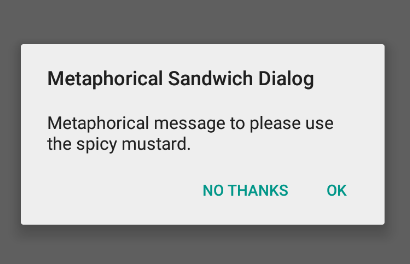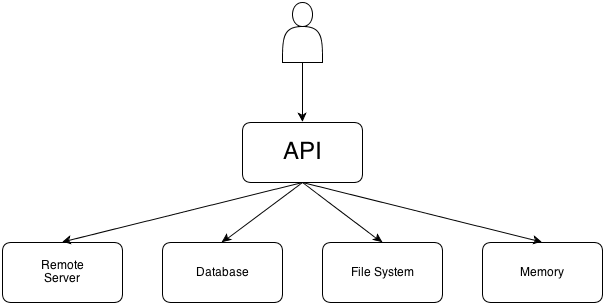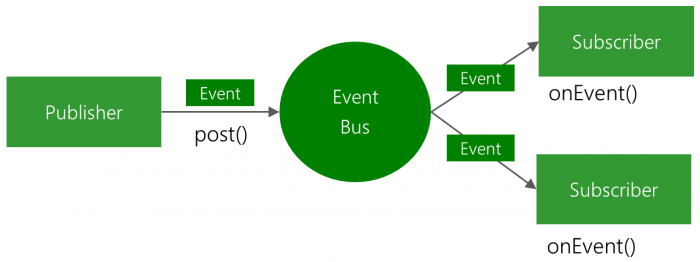 Beyond satisfying your clients and your employer, there’s one more
important individual to keep
Beyond satisfying your clients and your employer, there’s one more
important individual to keep happy in your career as a developer: Future You! (The artist’s conception of Future You to the right implies no guarantee of personal jetpack availabilty for developers in the near future.) :]
Future You will inherit the code you write at some point down the road, and will likely have a lot of questions about how and why you coded things the way you did. But instead of leaving tons of confusing comments in your code, a much better approach is to adopt common design patterns.
This article will introduce a few common design patterns for Android that you can use while developing apps. Design patterns are reusable solutions to common software problems. The design patterns covered here aren’t an exhaustive list, nor an academically-citable paper. Rather, they serve as a workable references and starting points for further investigation.
Getting Started
“Is there anywhere in this project where I’ll have to change the same thing in multiple places?” – Future YouFuture You should minimize time spent doing “detective work” looking for intricate project dependencies, so they would prefer a project that’s as reusable, readable, and recognizable as possible. These goals span a single object all the way up to the entire project and lead to patterns that fall into the following categories:
- Creational patterns: how you create objects.
- Structural patterns: how you compose objects.
- Behavioral patterns: how you coordinate object interactions.
In the sections that follow, you’ll cover the following patterns from each category and see how they apply to Android:
Creational
- Builder
- Dependency Injection
- Singleton
- Adapter
- Facade
- Command
- Observer
- Model View Controller
- Model View ViewModel
Note: This article isn’t like a
traditional raywenderlich.com tutorial in that it doesn’t have an
accompanying sample project that you can follow along with. Treat it
instead like an article to get you up to speed to the different patterns
you’ll see used in our other Android tutorials, and to discover ways to
improve your own code.
Creational Patterns
“When I need a particular complex object, how do I get one?” – Future YouFuture You hopes the answer is not “copy and paste the same code every time you need an instance of this object.” Instead, creational patterns make object creation simple and easily repeatable.
Here are several examples:
Builder
At a sandwich spot down my block, I use a small pencil to check off the bread, ingredients, and condiments I’d like on my sandwich from a checklist on a slip of paper. Even though the checklist’s title instructs me to “build my own” sandwich, I really only fill out the form and hand it over the counter. I’m not actually doing the sandwich-building, just the customizing…and the consuming. :]Similarly, the Builder pattern separates the construction of a complex object (the slicing of bread, the stacking of pickles) from its representation (a yummy sandwich); in this way, the same construction process can create different representations.
In Android, the Builder pattern appears when using objects like
AlertDialog.Builder:new AlertDialog.Builder(this) .setTitle("Metaphorical Sandwich Dialog") .setMessage("Metaphorical message to please use the spicy mustard.") .setNegativeButton("No thanks", new DialogInterface.OnClickListener() { @Override public void onClick(DialogInterface dialogInterface, int i) { // "No thanks" button was clicked } }) .setPositiveButton("OK", new DialogInterface.OnClickListener() { @Override public void onClick(DialogInterface dialogInterface, int i) { // "OK" button was clicked } }) .show(); |
AlertDialog that matter to you. Take a look at the AlertDialog.Builder documentation; you’ll see there are quite a few commands to choose from when building your alert.The code block above produces the following alert:

A different set of choices would result in a completely different sandwich – er, alert. :]
Dependency Injection
Dependency injection is like moving into a furnished apartment. Everything you need is already there; you don’t have to wait for furniture delivery or follow pages of IKEA instructions to put together a Borgsjö bookshelf.In strictly software terms, dependency injection has you provide any objects required when you instantiate a new object; the new object doesn’t need to construct or customize the objects itself.
In Android, you might find you need to access the same complex objects from various points in your app, such as a network client, an image loader, or
SharedPreferences for local storage. You can inject these objects into your activities and fragments and access them right away.Dagger 2 is the most popular open-source dependency injection framework for Android and was developed in collaboration between Google and Square. You simply annotate a class with
@Module, and populate it with @Provides methods such as the following:@Module public class AppModule { @Provides SharedPreferences provideSharedPreferences(Application app) { return app.getSharedPreferences("prefs", Context.MODE_PRIVATE); } } |
Then, you make a Component interface to list your modules and the classes you’ll inject:
@Component(modules = AppModule.class) interface AppComponent { ... } |
Finally, you use the
@Inject annotation to request the dependency wherever you need it:@Inject SharedPreferences sharedPreferences;
|
SharedPreferences object came to be.Admittedly this is a simplified overview, but you can read up on the Dagger documentation for more detailed implementation details. This pattern may seem complicated and “magical” at first, but its use can help simplify your activities and fragments.
Singleton
The Singleton Pattern specifies that only a single instance of a class should exist with a global point of access. This works well when modeling real-world objects only having one instance:public class ExampleSingleton { private static ExampleSingleton instance = null; private ExampleSingleton() { // customize if needed } public static ExampleSingleton getInstance() { if (instance == null) { instance = new ExampleSingleton(); } return instance; } } |
getInstance() to ensure you only initialize the class once. When you need to access the singleton object, you simply make a call as follows:ExampleSingleton.getInstance(); |
The Singleton is probably the easiest pattern to initially understand, but can be dangerously easy to overuse – and abuse. Since it’s accessible from multiple objects, the singleton can undergo unexpected side effects that are difficult to track down – exactly what Future You doesn’t want to deal with. It’s important to understand the pattern, but other design patterns may be safer and easier to maintain.
Structural Patterns
“So when I open up this class, how will I remember what’s it’s doing and how it’s put together?” – Future YouFuture You will undoubtedly appreciate the Structural Patterns you used to help organize the guts of your classes and objects into familiar arrangements that perform typical tasks. Two commonly-seen patterns in Android are Adapter and Facade.
Adapter
A famous scene in the movie Apollo 13 features a team of engineers tasked with fitting a square peg into a round hole. This, metaphorically, is the role of an adapter. In software terms, this pattern lets two incompatible classes work together by converting the interface of a class into another interface the client expects.Consider the business logic of your app; it might be a Product, or a User, or a Tribble. It’s the square peg. Meanwhile, a
RecyclerView is the same basic object across all Android apps. It’s the round hole.In this situation, you can use a subclass of
RecyclerView.Adapter and implement the required methods to make everything work:public class TribbleAdapter extends RecyclerView.Adapter { private List mTribbles; public TribbleAdapter(List tribbles) { this.mTribbles = tribbles; } @Override public TribbleViewHolder onCreateViewHolder(ViewGroup viewGroup, int i) { LayoutInflater inflater = LayoutInflater.from(viewGroup.getContext()); View view = inflater.inflate(R.layout.row_tribble, viewGroup, false); return new TribbleViewHolder(view); } @Override public void onBindViewHolder(TribbleViewHolder viewHolder, int i) { viewHolder.configure(mTribbles.get(i)); } @Override public int getItemCount() { return mTribbles.size(); } } |
RecyclerView doesn’t know what a Tribble is, as it’s
never seen a single episode of Star Trek – not even the new movies. :]
Instead, it’s the adapter’s job to handle the data and send the
configuration command to the correct ViewHolder.Facade
The Facade pattern provides a higher-level interface that makes a set of other interfaces easier to use. The following diagram illustrates this idea in more detail:
If your Activity needs a list of books, it should be able to ask a single object for that list without understanding the inner workings of your local storage, cache, and API client. Beyond keeping your Activities and Fragments code clean and concise, this lets Future You make any required changes to the API implementation without any impact on the Activity.
Retrofit from SquareOne is an open-source Android library that helps you implement the Facade pattern; you create an interface to provide API data to client classes like so:
public interface BooksApi { @GET("/books") void listBooks(Callback<List> callback); } |
listBooks() to receive a list of Book
objects in the callback. It’s nice and clean; for all it knows, you
could have an army of Tribbles assembling the list and sending it back
via transporter beam. :]This lets you make all types of customizations underneath without affecting the client. For example, you can specify a customized JSON deserializer about which the Activity has no clue:
RestAdapter restAdapter = new RestAdapter.Builder() .setConverter(new MyCustomGsonConverter(new Gson())) .setEndpoint("http://www.myexampleurl.com") .build(); return restAdapter.create(BooksApi.class); |
MyCustomGsonConverter, working behind the scenes as a JSON deserializer. With Retrofit, you can further customize operations with RequestInterceptor and OkClient to control caching behavior without the client knowing what’s going on.The less each object knows about what’s going on behind the scenes, the easier it will be for Future You to manage changes in the app. This pattern can be used in a lot of other contexts; Retrofit is only one mechanism among many.
Behavioral Patterns
“So… how do I tell which class is responsible for what?” – Future YouBehavioral patterns let you assign responsibility for different app functions; Future You can use them to navigate the structure and architecture of the project. These patterns can vary in scope, from the relationship between two objects to the entire architecture of your app. In many cases, the various behaviorial patterns are used together in the same app.
Command
When you order some excellent Saag Paneer at an Indian restaurant, you don’t necessarily know which cook will prepare your dish; you only give your order to the waiter, who posts the order in the kitchen for the next available cook.Similarly, the Command pattern lets you issue requests without knowing the receiver. You encapsulate a request as an object and send it off; deciding how to complete the request is an entirely separate mechanism.
Greenrobot’s EventBus is a popular Android framework that supports this pattern in the following manner:

An
Event is a command-style object that can be triggered
by user input, server data, or pretty much anything else in your app.
You can create specific subclasses which carry data as well:public class MySpecificEvent { /* Additional fields if needed */ } |
EventBus and register an object as a subscriber:eventBus.register(this); |
public void onEvent(MySpecificEvent event) {/* Do something */}; |
eventBus.post(event); |
Observer
The Observer pattern defines a one-to-many dependency between objects. When one object changes state, all of its dependents are notified and updated automatically.This is a versatile pattern; you can use it for operations of indeterminate time, such as API calls. You can also use it to respond to user input.
The RxAndroid framework (aka Reactive Android) will let you implement this pattern throughout your app:
apiService.getData(someData) .observeOn(AndroidSchedulers.mainThread()) .subscribe (/* an Observer */); |
Observable objects that will emit values. These values can emit all at once, as a continuous stream, or at any rate and duration.Subscriber objects will listen for these values
and react to them as they arrive. For example, you can open a
subscription when you make an API call, listen for the response from the
server, and react accordingly.Model View Controller
Model View Controller refers to the current reigning architectural pattern across several platforms; it’s particularly easy to set your project up in this way on Android. It refers to the three divisions of classes used in this pattern:- Model: your data classes. If you have
UserorProductobjects, these “model” the real world. - View: your visual classes. Everything the user sees falls under this category.
- Controller: the glue between the two. It updates the view, takes user input, and makes changes to the model.
Future You will eventually get a request from the client to add a new screen to the app, but simply using the existing data in the app; following the MVC paradigm means Future You can easily re-use the same models and only change the views. Or perhaps the client will ask Future You to move that fancy widget from the home screen to the detail screen. Separating your view logic makes this an easy task.
Additionally, moving as much layout and resource logic as possible into Android XML keeps your View layer clean and tidy. Nice!
You may have to do some drawing in Java from time to time, in which case it will help to separate the drawing operations from your activity and fragment classes.
Over time, you’ll find making architectural decisions becomes easier under MVC and Future You can more easily solve issues as they arise.
Model View ViewModel
This unfortunately-quite-confusingly-named architectural pattern is similar to the MVC pattern; the Model and View components are the same. The ViewModel object is the “glue” between the model and view layers, but operates differently than the Controller component. Instead, it exposes commands for the view and binds the view to the model. When the model updates, the corresponding views update as well via the data binding. Similarly, as the user interacts with the view, the bindings work in the opposite direction to automatically update the model. This reactive pattern removes a lot of glue code.The MVVM pattern is trending upwards in popularity but is still a fairly recent addition to the pattern library. Future You would love it if you kept your eye on this one! :]
Where to Go From Here?
While it feels great to keep abreast of the latest flashy APIs, keeping your apps updated can quickly lead to redesign-fatigue. Investing in software design patterns early on will improve your return on development time; you’ll start to notice you get more done with less effort.I recommend checking out timeless classics such as Design Patterns by the “Gang of Four.” Compared to Material Design or Android Wear, this book might be considered “ancient”, but documents many useful design patterns that predate Android itself !
I hope this article serves as a starting point for your research into common design patterns for Android! If you have any questions or comments, feel free to join the forum discussion below – Future You would be happy if you did. :]





0 comments:
Post a Comment
Note: only a member of this blog may post a comment.